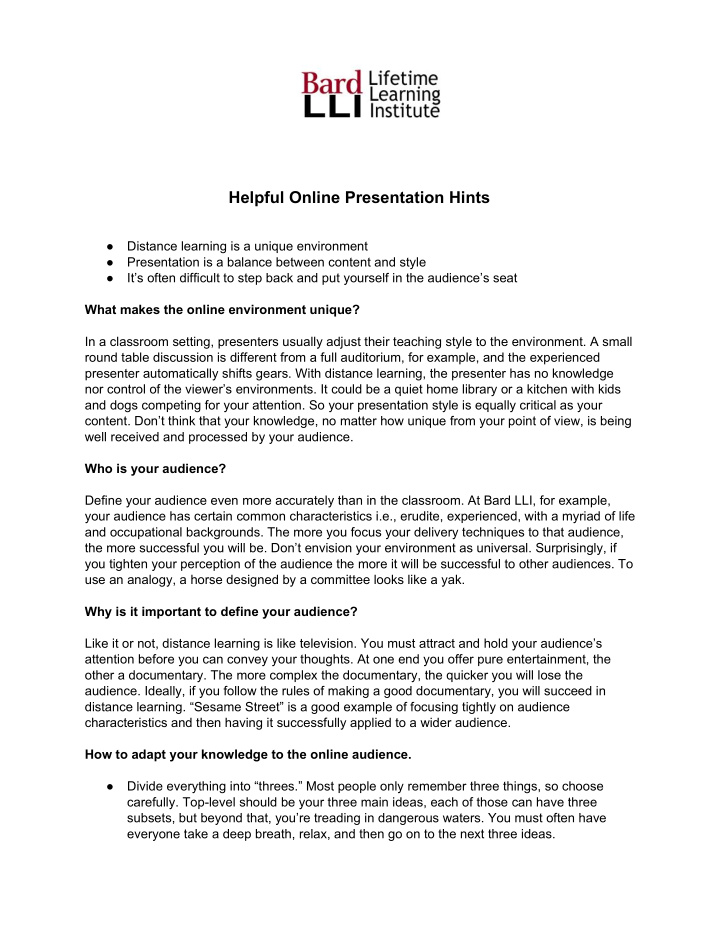



Helpful Online Presentation Hints ● Distance learning is a unique environment ● Presentation is a balance between content and style ● It’s often difficult to step back and put yourself in the audience’s seat What makes the online environment unique? In a classroom setting, presenters usually adjust their teaching style to the environment. A small round table discussion is different from a full auditorium, for example, and the experienced presenter automatically shifts gears. With distance learning, the presenter has no knowledge nor control of the viewer’s environments. It could be a quiet home library or a kitchen with kids and dogs competing for your attention. So your presentation style is equally critical as your content. Don’t think that your knowledge, no matter how unique from your point of view, is being well received and processed by your audience. Who is your audience? Define your audience even more accurately than in the classroom. At Bard LLI, for example, your audience has certain common characteristics i.e., erudite, experienced, with a myriad of life and occupational backgrounds. The more you focus your delivery techniques to that audience, the more successful you will be. Don’t envision your environment as universal. Surprisingly, if you tighten your perception of the audience the more it will be successful to other audiences. To use an analogy, a horse designed by a committee looks like a yak. Why is it important to define your audience? Like it or not, distance learning is like television. You must attract and hold your audience’s attention before you can convey your thoughts. At one end you offer pure entertainment, the other a documentary. The more complex the documentary, the quicker you will lose the audience. Ideally, if you follow the rules of making a good documentary, you will succeed in distance learning. “Sesame Street” is a good example of focusing tightly on audience characteristics and then having it successfully applied to a wider audience. How to adapt your knowledge to the online audience. ● Divide everything into “threes.” Most people only remember three things, so choose carefully. Top-level should be your three main ideas, each of those can have three subsets, but beyond that, you’re treading in dangerous waters. You must often have everyone take a deep breath, relax, and then go on to the next three ideas.
● Keep it simple. Going by the understanding that your audience’s environment can be complex and distracting, simpler is better. Relax, do one thing and do it well, then move on. ● Each nugget of knowledge should be a story itself. If you present your knowledge as a story you will cause the audience to pay attention. Instead of saying, for example, “always add acid to water,” phrase it as “A student who adds water to acid will often think everything is OK until — BOOM! — an explosion suffocates him or her. Do you want this to happen to you?” The dreaded PowerPoint or Keynote slide. If you learn how to produce good slides, your presentation is 90% finished. Like painting your kitchen, preparation is everything. Sand, sand, sand...then paint. If you don’t learn how to make good slides you will drastically reduce the effectiveness of your class. Here are the ten most helpful suggestions. 1. Keep slides as simple and clear as you can. Three bullet points or sentences are ideal. An easy-to-read chart or graph is great. Do not put up a paragraph of words or ten bullet points. The rule of thumb is that you must leave a slide up long enough for your audience to read twice. As they say, do the math. Keep it short and simple. 2. Keep your slides graphically simple as well. Simple backgrounds, consistent throughout your presentation, are best. Do not use stark white or absolute black backgrounds. Light grey with black lettering is most readable. White lettering against black is often difficult, depending on the font, but sometimes you’re looking for something more elegant than black on white. 3. Do not use fancy transitions, animations, or colors to make your point. The audience will focus more on your “special” effects more than what you are trying to say. A 1.5-second dissolve works well, as it softens the hard cut of a slide with no transition. Spins and flips and zooms should be avoided. In fact, take them out of your vocabulary :-) 4. Use easy-to-read fonts. Sans serif, proper size in relation to the amount of content, is important. 5. Write slides that cause your audience to think. The best slides are ones that cause viewers to answer questions and then answer them. Sometimes simply putting up a question does the trick. 6. When designing bullet points, do them as simple transitions. That is, put one up and talk. Then dissolve to one revealing two, first one dimmed slightly. Same with third. Then have all three on-screen full brightness. 7. Allow the audience to digest a slide before speaking. Along the same line, ask a question, pause, then put up a slide with the answer. Give the audience a chance to pause and breathe.
8. Use video by linking to Vimeo or YouTube. Video is an excellent medium, but remember sound (your voice) is the most important. When sharing a screen that contains video, make you check the boxes in lower left “use computer audio” and “optimize video quality.” 9. Divide your presentation into chapters or lessons. Firstly, it reduces file size. Secondly, it makes finding content easier than having to scroll through hundreds of slides. 10. Stay on pace, which should be lively. Do not talk excessively while one slide is on the screen. Instead, make more slides and divide your thoughts over a larger number of slides. Each presenter has their own personality, style, and methods. One size does not fit all. But if you deliver your knowledge in a simple, yet effective, online format, you will have succeeded.
Recommend
More recommend